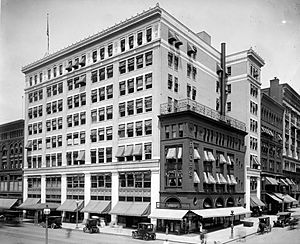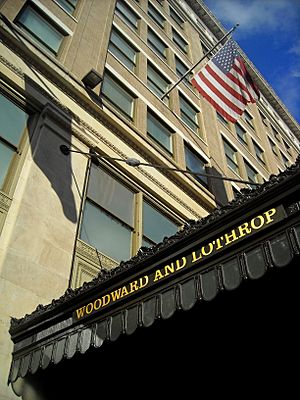- This page was last modified on 17 October 2025, at 10:18. Suggest an edit.
Woodward & Lothrop facts for kids
| Industry | Retail |
|---|---|
| Fate | Bankruptcy |
| Founded | 1887 |
| Defunct | November 1995 |
| Headquarters | Washington, D.C., U.S. |
| Products | General Merchandise |
Woodward & Lothrop was a famous department store chain. It started in Washington, D.C. in 1887. People often called it Woodies. It was the first department store in the capital city.
Woodies had many stores in the Mid-Atlantic part of the United States. Its main store was a big part of Washington, D.C.'s downtown shopping area. It competed with other stores like Garfinckel's. It even bought another store called Palais Royal.
Sadly, the company faced problems. It filed for bankruptcy in January 1994. All its stores closed by November 1995. Most locations were sold to other companies like J. C. Penney or May Department Stores Company. The main store building in D.C. is now a historic landmark. It was a big part of discussions about how to rebuild downtown Washington after Woodies closed. Another old building, the Woodward & Lothrop Service Warehouse, is also a landmark.
Contents
The Story of Woodies

The Woodward & Lothrop store in Washington, D.C. around the 1910s.
Samuel Walter Woodward (born 1848) and Alvin Mason Lothrop (born 1847) were the founders. They first opened a dry goods store in Chelsea, Massachusetts, in 1873. They had several stores in the Boston area.
In 1880, they moved their business to Washington, D.C. They partnered with Charles E. Cochrane. Their first store was at 705 Market Space. This spot is now near the United States Navy Memorial.
Their first store was very popular. So, they moved to a bigger place at 921 Pennsylvania Avenue within a year. After a flood in 1886, they moved again. This time, they went to the corner of 11th and F Streets NW. Woodward and Lothrop then bought out Cochrane's share. The store was renamed Woodward & Lothrop.
Growing into the Suburbs
After World War II, Woodies started opening stores in suburban shopping malls. However, the families who owned the company grew slowly. They did not want to merge with other big chains.
In the 1980s, other companies tried to buy Woodies. In 1984, a businessman named A. Alfred Taubman bought the company for $277 million. He also bought other stores like Wanamaker's in Philadelphia.
Why Woodies Closed
Mr. Taubman took on a lot of debt when he bought these companies. Then, in the early 1990s, there was a small economic downturn. This recession especially affected real estate and department stores. Washington, D.C., also saw less government spending after the Cold War ended. This made people less confident about spending money.
Because of these problems, Woodward & Lothrop filed for bankruptcy on January 18, 1994. They had more debts than assets. Even with big cost cuts and more sales, the company could not make a profit.
So, the chain, including its Wanamaker's stores, had to close. By June 1995, seven Woodies stores were sold to J. C. Penney. The rest, along with the Wanamaker's stores, went to May Department Stores Company. All Woodies stores had their final sales and closed forever by November 1995.
The Main Store Building

The Woodward & Lothrop's main store being built in Washington, D.C..
The main Woodward & Lothrop store quickly grew after moving into the Carlisle building in 1887. It bought nearby buildings. By 1897, it covered almost a whole city block. The building was updated with a new look in 1898 and 1902. More floors were added in 1912, 1913, and 1925.
The building reached its final design in 1927. It was ten stories tall and had over 400,000 square feet of shopping space. The outside had fancy cast iron and leaded glass decorations. These included flower designs and the Woodward & Lothrop monogram. It became a D.C. Historic Landmark in 1964.

The Woodward & Lothrop entrance sign at the old main store in Washington, D.C. (2008).
In the 1980s, architect Michael Graves redesigned the first floor. He added the company's special W&L monogram plaques to the columns.
What Happened After Woodies Closed?
After the store closed, the building was empty for a while. City leaders and developers argued about what to do with it. The city wanted a Macy's store there, but Macy's said no. The building was too big and needed too much work. Also, downtown shopping was not as popular as suburban malls.
In 1996, the Washington National Opera bought the building. They wanted to turn it into an opera house. But it would cost $200 million to change the retail space into an opera house. This was too much money.
So, the building stayed empty until 1999. Then, a developer named Douglas Jemal bought it. He wanted to use it for offices and shops. But local groups wanted it to have arts spaces, restaurants, and homes too. The city's Zoning Commission did not approve Jemal's plan. The building remained empty for two more years.
Finally, in 2001, the Commission approved the retail-office plan. Renovation work began. The building reopened in 2003, almost ten years after Woodies closed. The Swedish clothing store Hennes & Mauritz (H&M) was one of the first big tenants.
New Stores and a Fire
On January 29, 2004, a fire broke out in the building. Firefighters quickly put out the fire. It was an accident, likely caused by a space heater.
In 2007, a furniture store called West Elm opened in the building. A three-floor Zara store also opened. The D.C. branch of Madame Tussauds wax museum opened in the building next door. This building, Rich's Shoes, had been a separate store even when Woodies expanded.
Besides the main store, the old Woodward & Lothrop Service Warehouse is also a landmark. It is located at 131 M Street in Northeast Washington. It was added to the National Register of Historic Places in 2005.
Woodies and the Community
Both Samuel Woodward and Alvin Lothrop were very active in their community. For example, Woodward became the president of the Washington City YMCA in 1898. He gave a lot of money to help fix up its buildings.
Woodward's daughter, Helen, and her husband also donated land. This land helped create the National Institutes of Health in Bethesda. After her husband died from cancer, Helen helped start the National Cancer Institute.
The Woodies store itself was a big part of people's lives. In the 1920s, it had over 67 different shopping departments. It also had a travel agency, a theater, a nurse's office, a merry-go-round, and art shows. Many people remember Woodies as a place for shopping, eating, and even talent shows. Young women from colleges would visit Woodies to buy their dresses for dances.
Special Products at Woodies
The Woodward & Lothrop toy department introduced some cool things to America.
Chemistry Sets
In 1916, Harold and John Porter started making chemistry sets. Woodward & Lothrop was the first big store to sell them. These "Chemcraft" kits soon became popular in toy stores everywhere.
Play-Doh
In the 1950s, the wife of a Woodies buyer saw a demonstration of Play-Doh modeling clay. This led to a successful demonstration in the store. Soon, Play-Doh was sold at Woodies and then in toy departments across the United States.
Slush Mugs
In the 1970s, Woodies was known for its slush mugs. These mugs could turn soda or fruit juice into smoothie-like "slush" drinks when frozen. They were a popular specialty item.
See also
- List of defunct department stores of the United States
